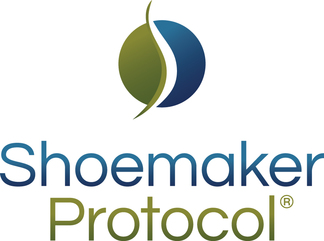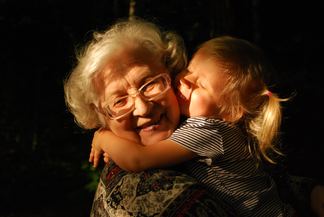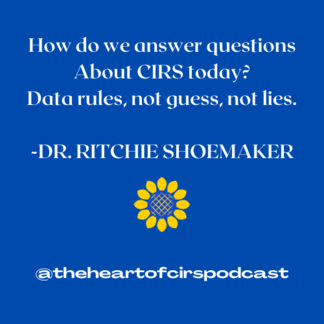Two New Papers: "Alternate Means to Make a CIRS Diagnosis" and "Peds VCS Norms"

Alternate Means to Make a CIRS Diagnosis
In 2006, Dr. Shoemaker published his 3-tiered case definition (CD) of CIRS. Using this CD requires demonstrating exposure to the interior of a water-damaged building (WDB), multi-system symptoms of CIRS, 3 of 6 objective signs and improvement with appropriate therapy. In 2008, the U.S. Government Accountability Office (GAO) published a report on indoor mold which created a similar CD for all illnesses thought to be caused by exposure to mold. The latter also required signs and symptoms consistent with published mold-based illness but did not enumerate more specific criteria. The GAO report also indicated that exposure is documented by the presence of visible mold, the ability to smell musty odors OR indoor growth of mold confirmed by commercial testing.
The problem with both these CDs is that diagnosis cannot be confirmed until after patient improvement. This means the patient must remove themselves from exposures, take an appropriate amount of binder medicine and return for follow up to meet the CD’s criteria. This is akin to only making the diagnosis of an ear infection after the patient has completed antibiotic therapy and improvement was documented with a follow up visit regardless of initial history, physical and a positive ear culture. The purpose of this research was to find a highly sensitive and specific way to make the diagnosis of CIRS without requiring patient compliance.
Dr. Shoemaker’s Clusters (positive cluster analysis is ≥6 clusters for children <11 years and ≥ 8 for those ≥11 years) were found to be highly sensitive for detecting CIRS. In other words, if sufficient clusters were not detected, it was very unlikely the patient had CIRS. Ten standard lab tests were performed and the total number of abnormal labs were evaluated (positive Labs ≥4 in children <11 years and ≥5 in those ≥11 years). Three Screens were also evaluated. The first was the total number of positive symptoms using Dr. Shoemaker’s standard roster of 37 (positive is ≥5 Sx in children ≤ 5 years, ≥8 Sx in children at least 5 years but < 11 years and ≥13 Sx in those ≥11 years). The second screen was a failed VCS test using an APT VCS Tester. The final screen was unilateral anti-gravity shoulder weakness. Labs and 3 of 3 abnormal Screens were found to be very specific for CIRS. This suggested that if a patient had positive Labs or positive Screens that it was very unlikely that some other illness besides CIRS was the diagnosis.
Combining the sensitivity of Clusters with the specificity of either Labs or Screens produced two methods of diagnosis that, when compared to the published CD’s, were highly accurate. The statistically predicted error rates vary by method from 1.24 in a thousand to 1.1 in a million cases. These methods were applied retrospectively to the entire chart population in the CIRS practice and nearly doubled the number of confirmed CIRS cases as compared to using CD’s alone. The pediatric population was enumerated and compared to the general pediatric population from which they came revealing a prevalence of at least 7.01% in children.
The importance of this is difficult to overstate. Initially, diagnosis is simplified to Clusters plus Labs or Clusters plus screens. The statistics demonstrate that both of these new diagnostic methods are sufficiently accurate to make the diagnosis for legal work, Daubert challenges, research and day to day management of patients. A confirmed diagnosis can be made with confidence at an initial visit, from chart review or when initial labs are received if criteria are met. Secondly, this work reveals more scientific evidence that cluster analysis, the labs we use, VCS testing and the symptom roster are all relevant and valid parts of making the CIRS diagnosis. Thirdly, it confirms that the intuitive means by which we make an individual’s diagnosis, combining history, physical exam, VCS and lab testing, are valid. Finally, this research presents the first known prevalence data of CIRS in children at a minimum of 7.01%. The prevalence in adults is assuredly higher. This suggests at least 22 million CIRS sufferers in the US alone.
The APT VCS Tester has been tested against its predecessor, the F.A.C.T tester, in adults and validated. Norms were described as being correct to the first ≥7 items in Column C (6 CPD or cycles per degree of visual arc) and correct to the first ≥6 items in Column D (12 CPD). No pediatric norms have been established for this test kit. The purpose of this study was to establish such norms.
Initially, 157 children from 7-18 years presenting for well checks were approached. An 8-question screening test was applied to detect potential CIRS patients. Five had known CIRS, 15 more failed the screening test and were excluded. Ten others were excluded for various reasons. In all, 127 healthy children were screened.
The results of VCS testing demonstrated no difference between boys and girls, between well-controlled asthmatics and those without asthma or between any age groups. The results also showed the same norms as with adult testing, specifically, correct to the first ≥7 items in Column C and to the first ≥6 items in Column D.
Of the 15 patients who were excluded for failing the screening questionnaire, 7 have been fully evaluated for CIRS and 8 were in varying stages of evaluation at the time of publication. All 7 of those with completed evaluation were shown to have CIRS. The minimum number of confirmed CIRS patients in this sampling of 157 “healthy” children was 12 and possibly as high as 20. This suggests a minimum prevalence of 7.6% and a maximum prevalence of 12.7% in this pediatric population.
This research is important because it created pediatric norms for VCS testing. Since CIRS appears to be preventable, by minimizing exposures, early detection is critical. VCS can be performed in most children at least 7 years of age. This study also created an instrument to screen even very young children for CIRS. The questionnaire needs to be validated, but is fast, easy to administer and conceivably could be used in children as young as 1-2 years old. The screen used picked up 15 potential CIRS patients out of 157 healthy individuals! As CIRS becomes more well known, such an instrument could be crucial for pediatric practitioners to determine which children need CIRS labs and/or genomics testing. Also, this research showed no gender differences or difference in those with well-controlled asthma. Finally, prevalence data were generated from a “healthy” population. CIRS prevalence in these children was somewhere between 7.6% and 12.7%. Prevalence is no doubt greater in adults. These data suggest somewhere between at least 23 million and more than 38 million CIRS sufferers in the US. The epidemic is upon us. Education, screening and treating while young seems the best way to minimize the impact.
Featured Resources for Community
Shoemaker Protocol™ Quick Start:
The 3 initial steps to determine if mold is affecting you One of the most common questions we hear is, “how do I know if I have mold illness?” Rest assured, if you’re asking this question, you’ve come to the right place.
Joint Surviving Mold/ CIRSx Conference May 17-19, 2024 in Frisco, TX
With a world-renowned lineup of speakers including keynote Ritchie Shoemaker, MD, from May 17th-19th.
Dr. Scott McMahon & Dr. Ritchie Shoemaker on Episode 415 of the Dr. Jordan B. Peterson Podcast
Dr. Jordan B. Peterson speaks with Dr. Scott McMahon and Dr. Ritchie Shoemaker. They discuss their potentially groundbreaking research into CIRS, or Chronic Inflammatory Response Syndrome.
Guidelines for Preventing Exposure (through the holidays and always)
It does take diligence and some proactive planning, but preventing mold exposure and thriving with CIRS is doable and possible, even through the busy holiday season. There are apparent consistencies, practices, and behaviors among those who thrive with CIR...
The Heart of CIRS Podcast with Melanie Joy Pensak
Heartfelt conversations with folks recovering from CIRS & with those special people serving the CIRS community (Chronic Inflammatory Response Syndrome).



